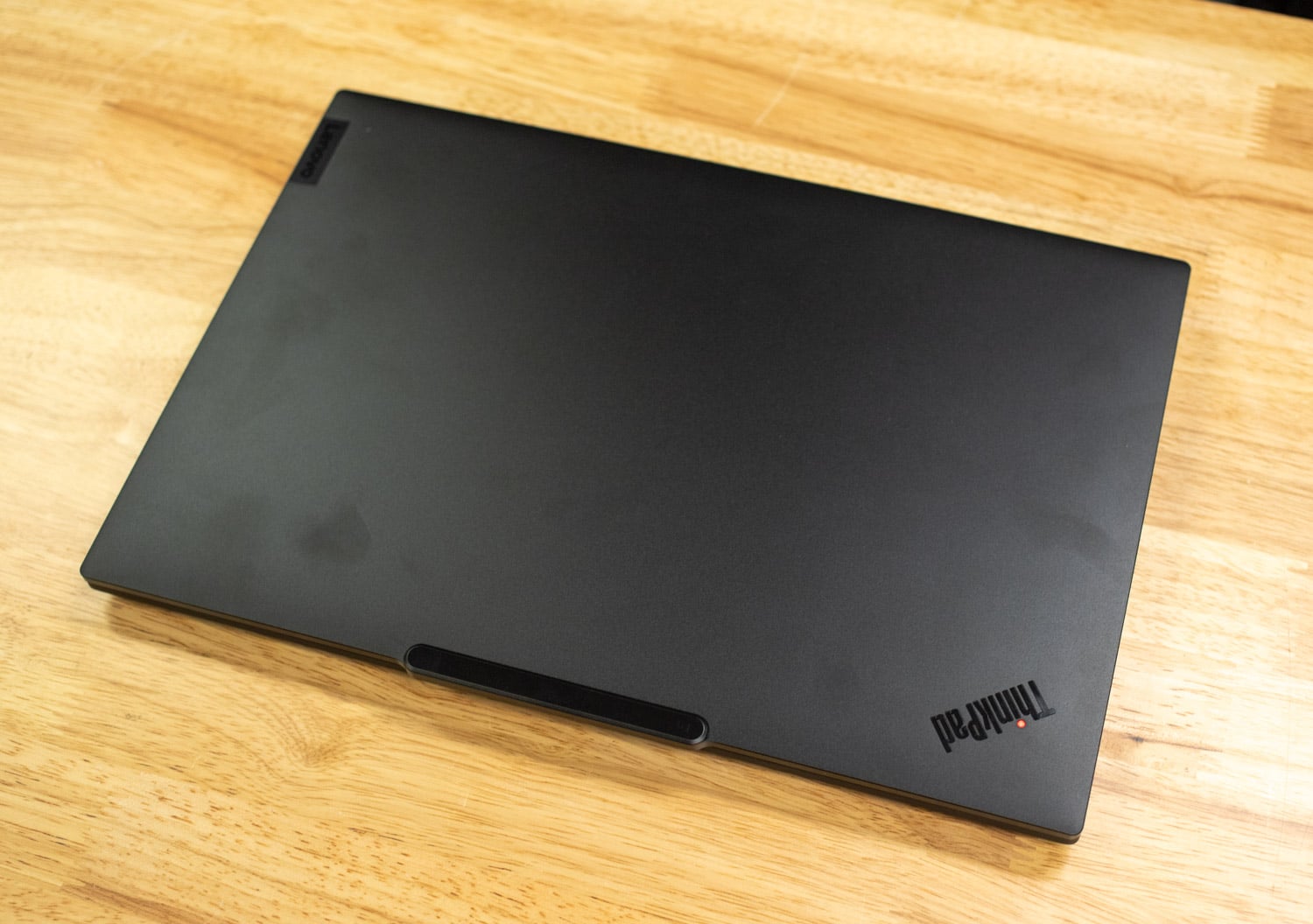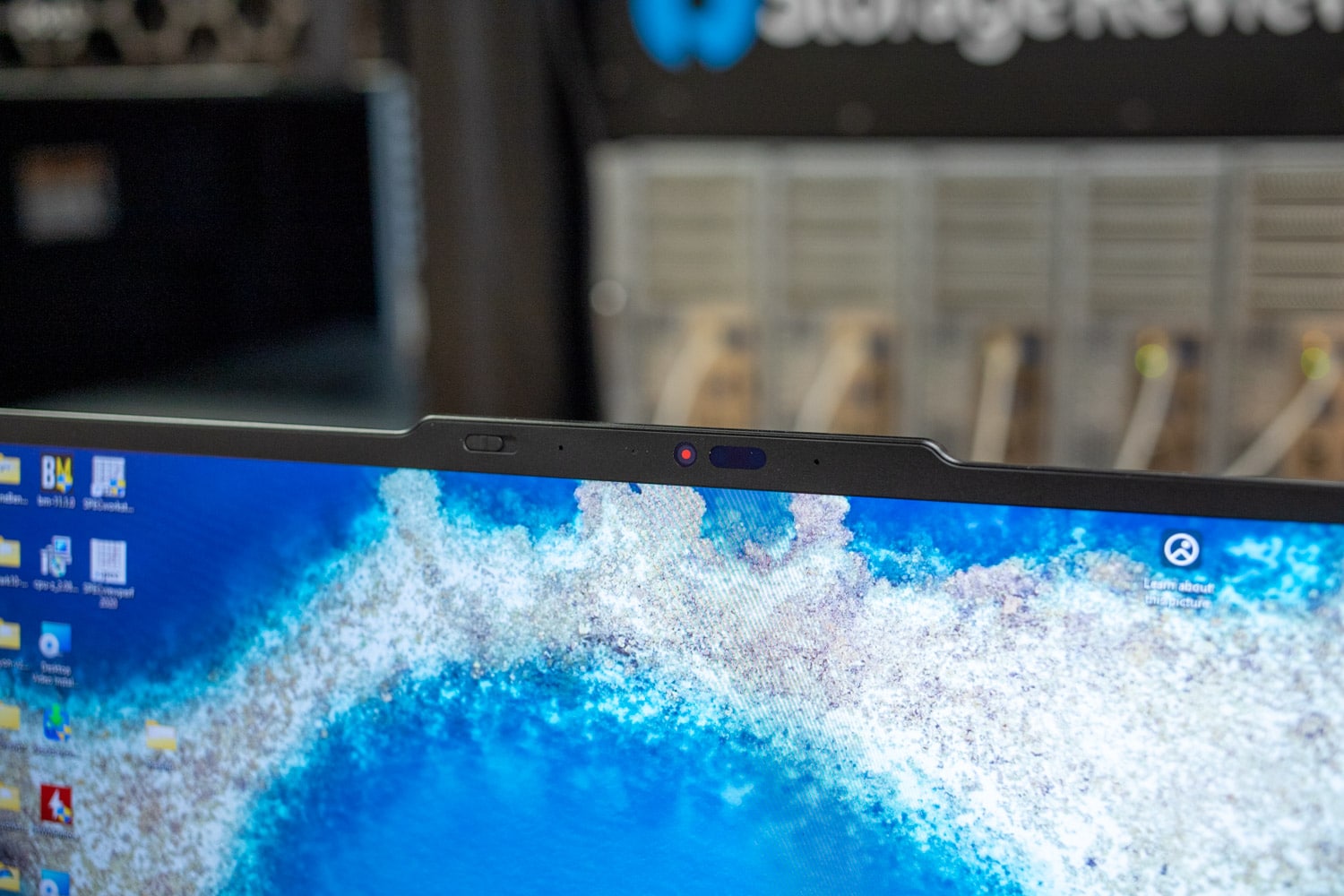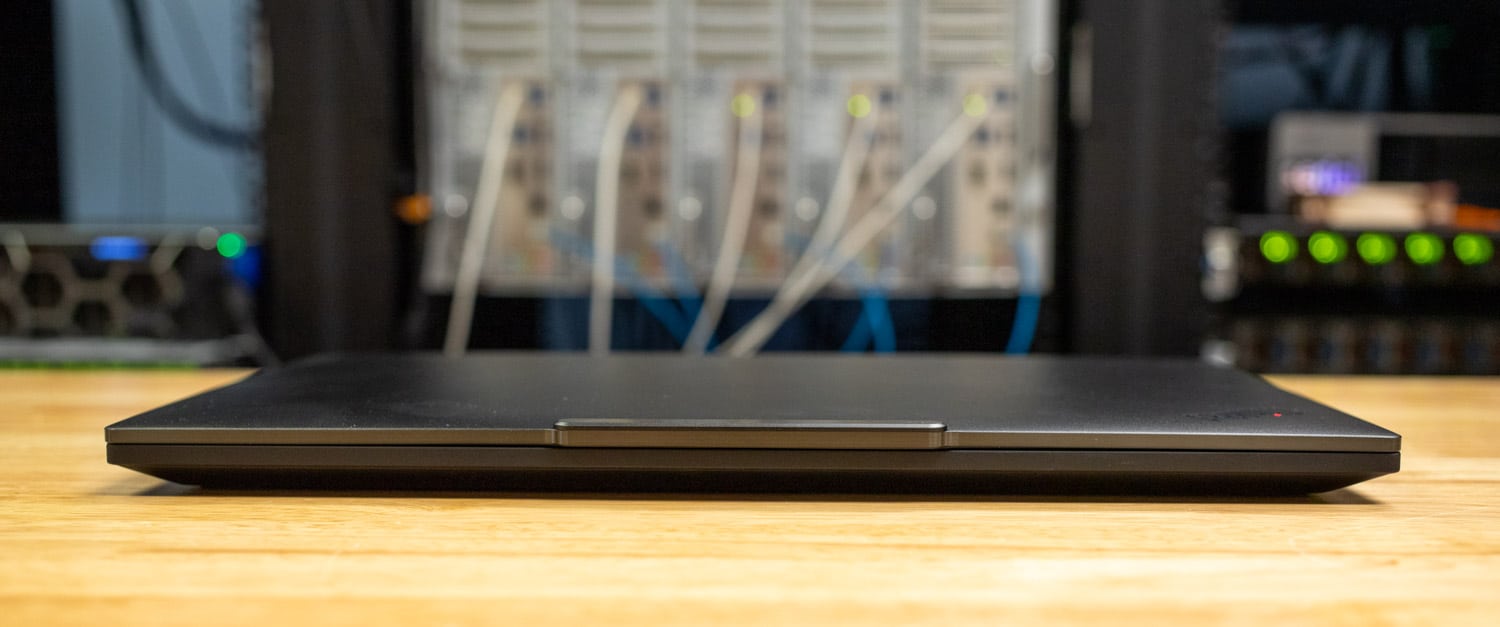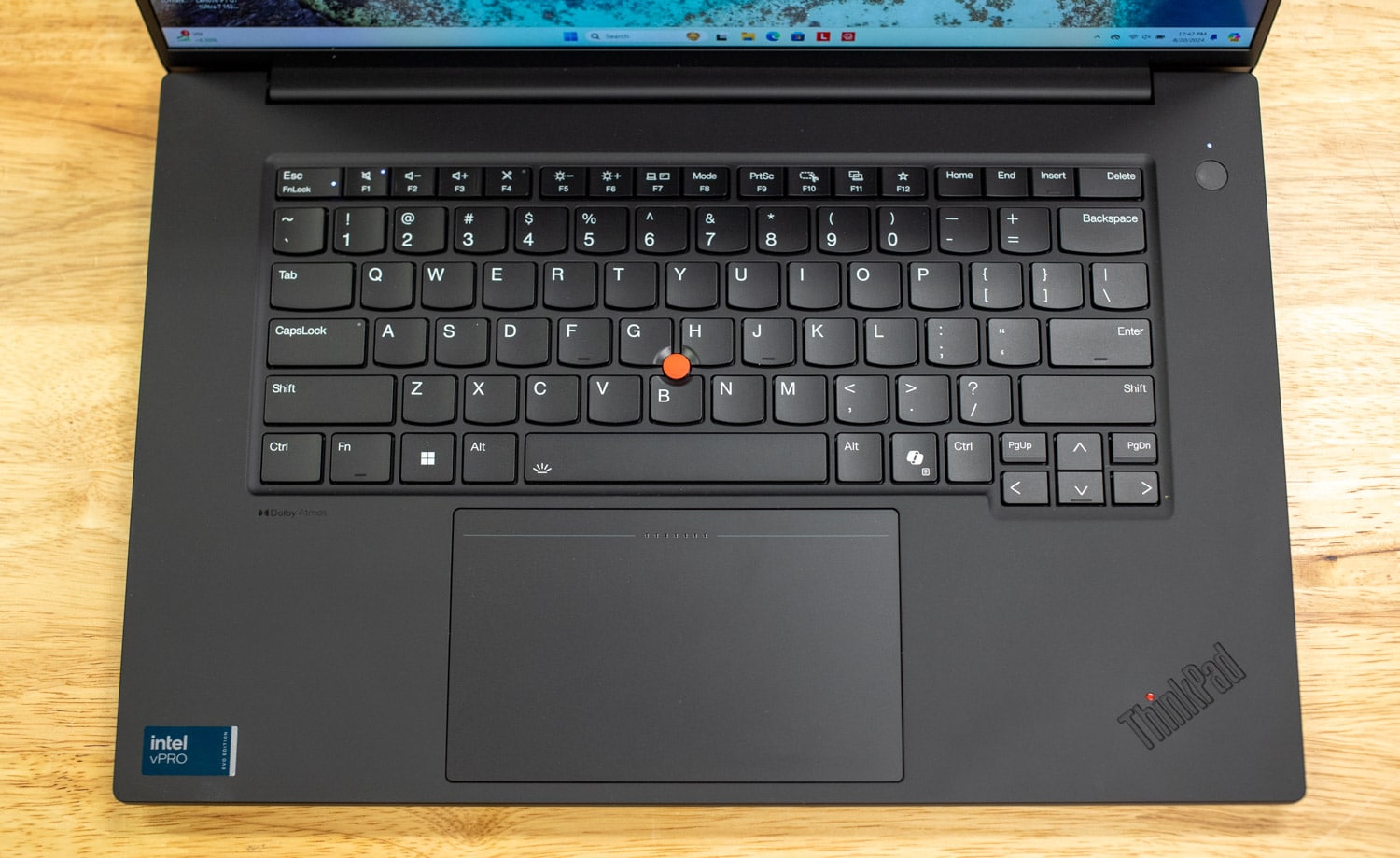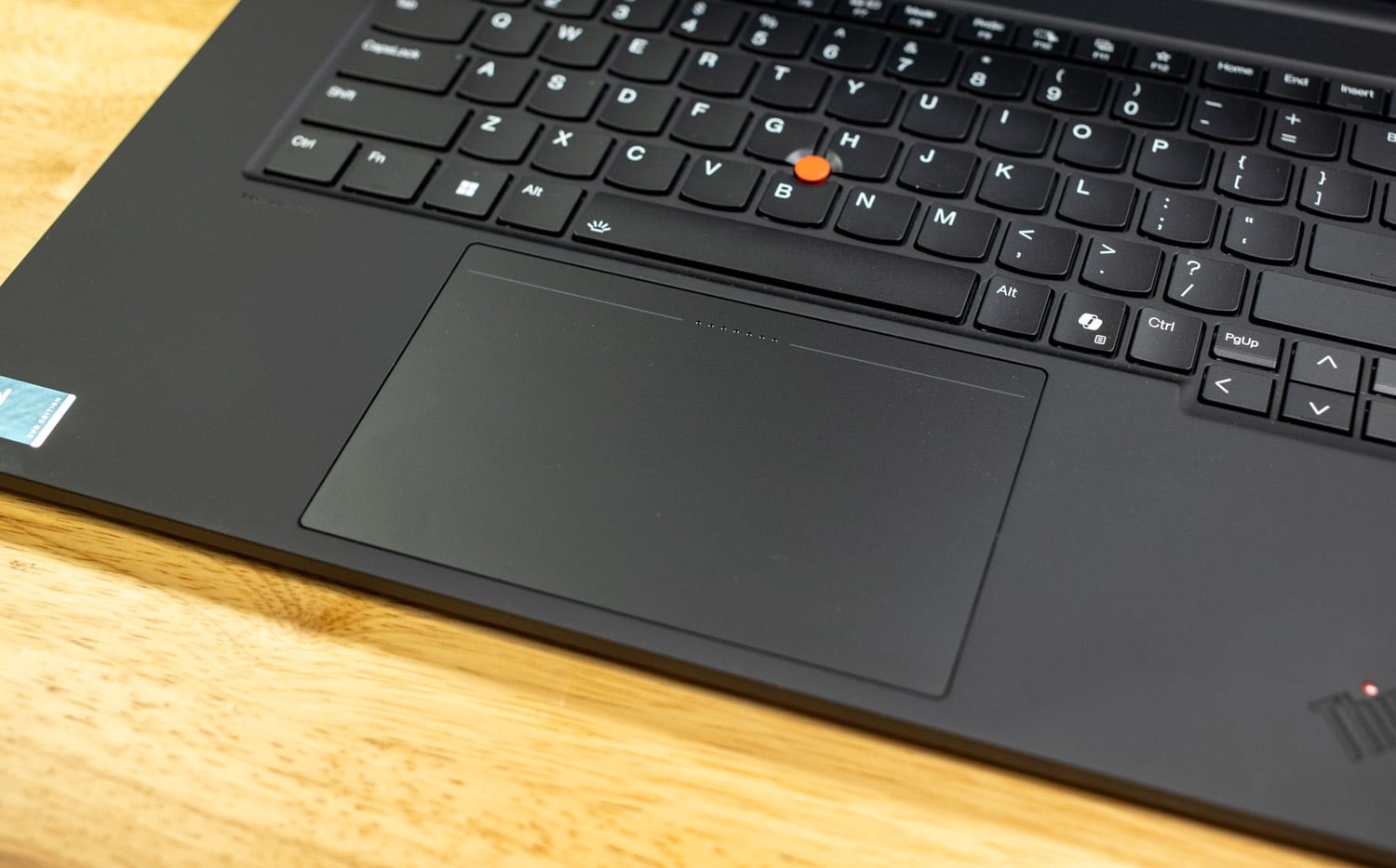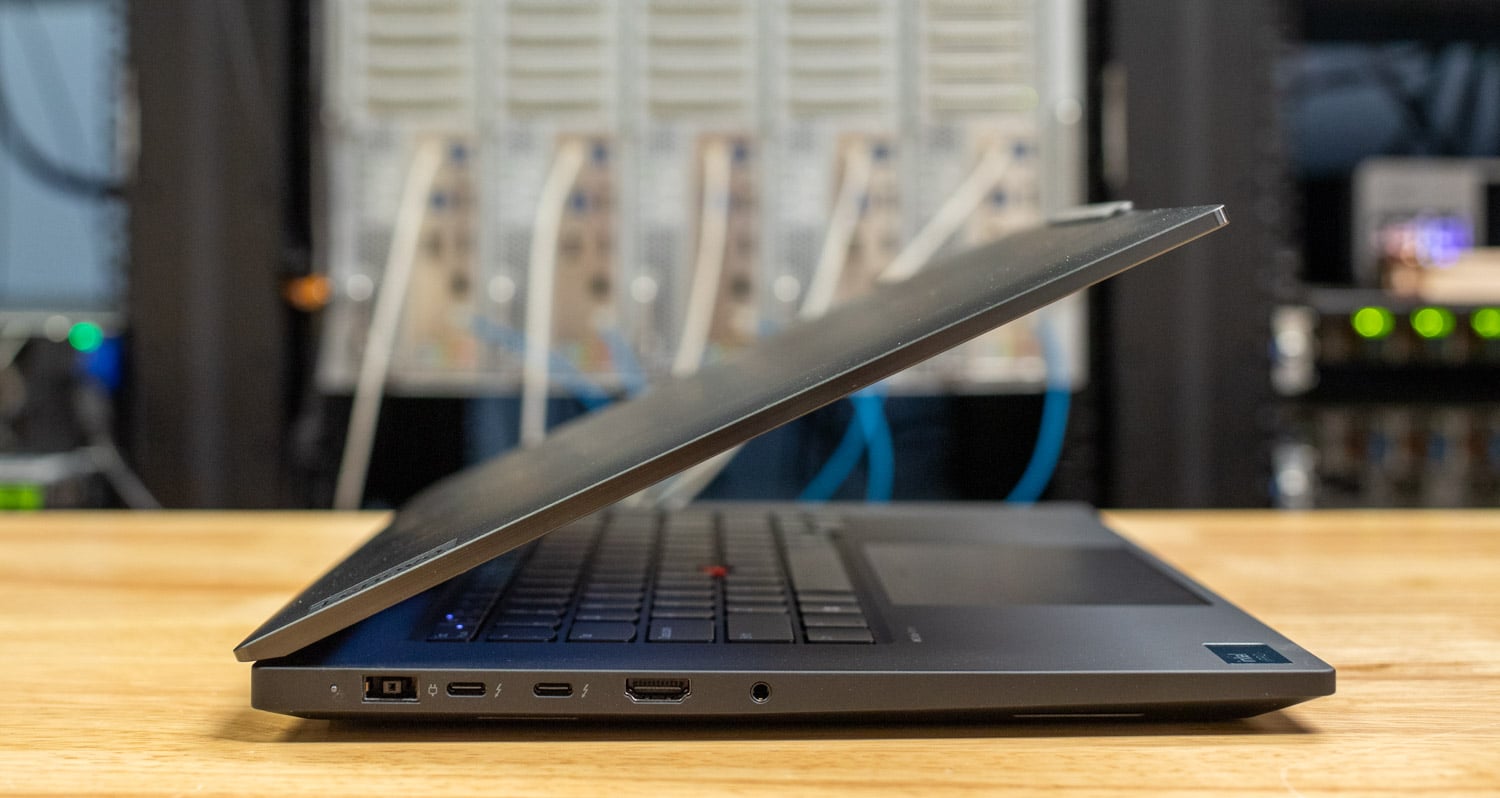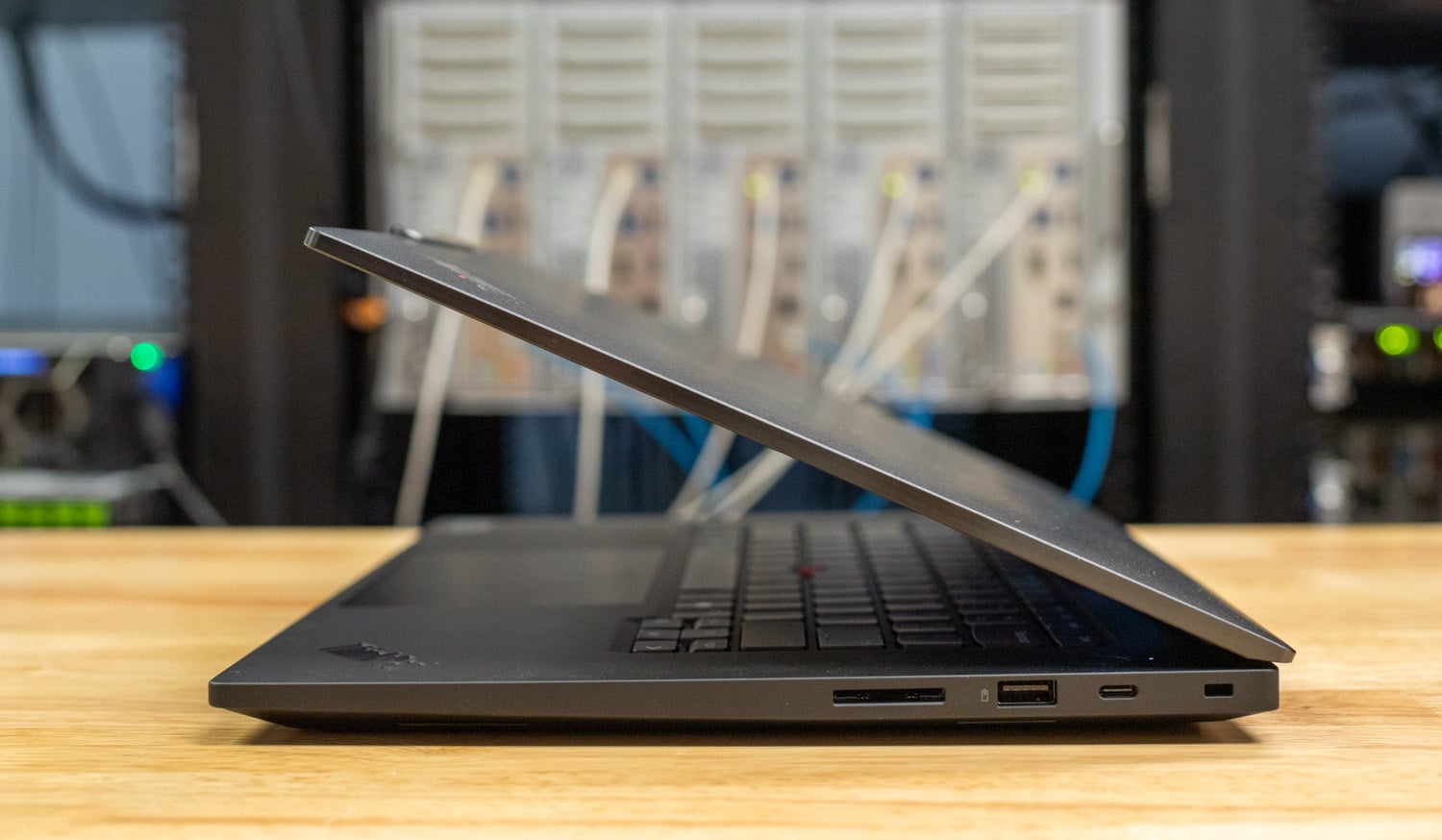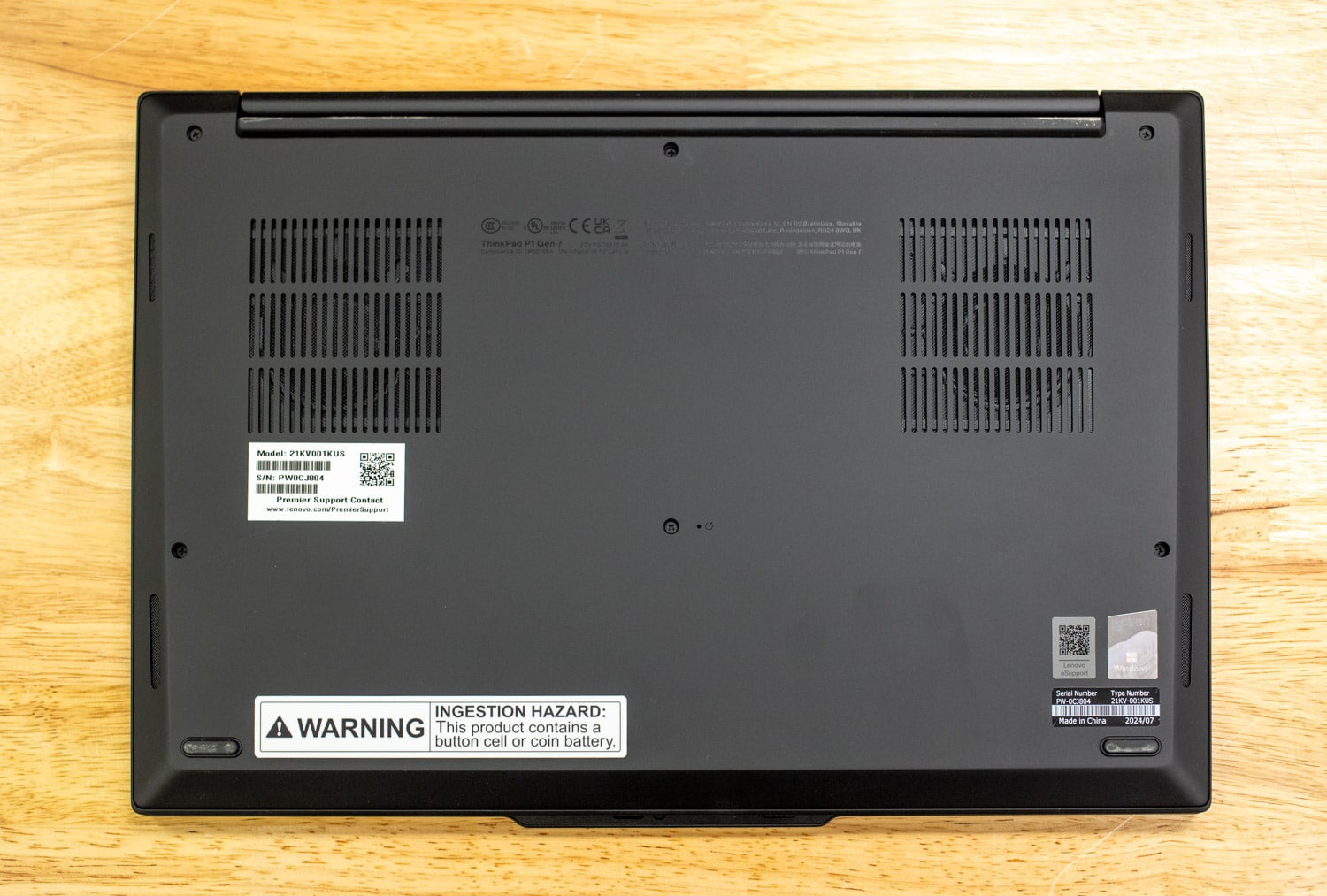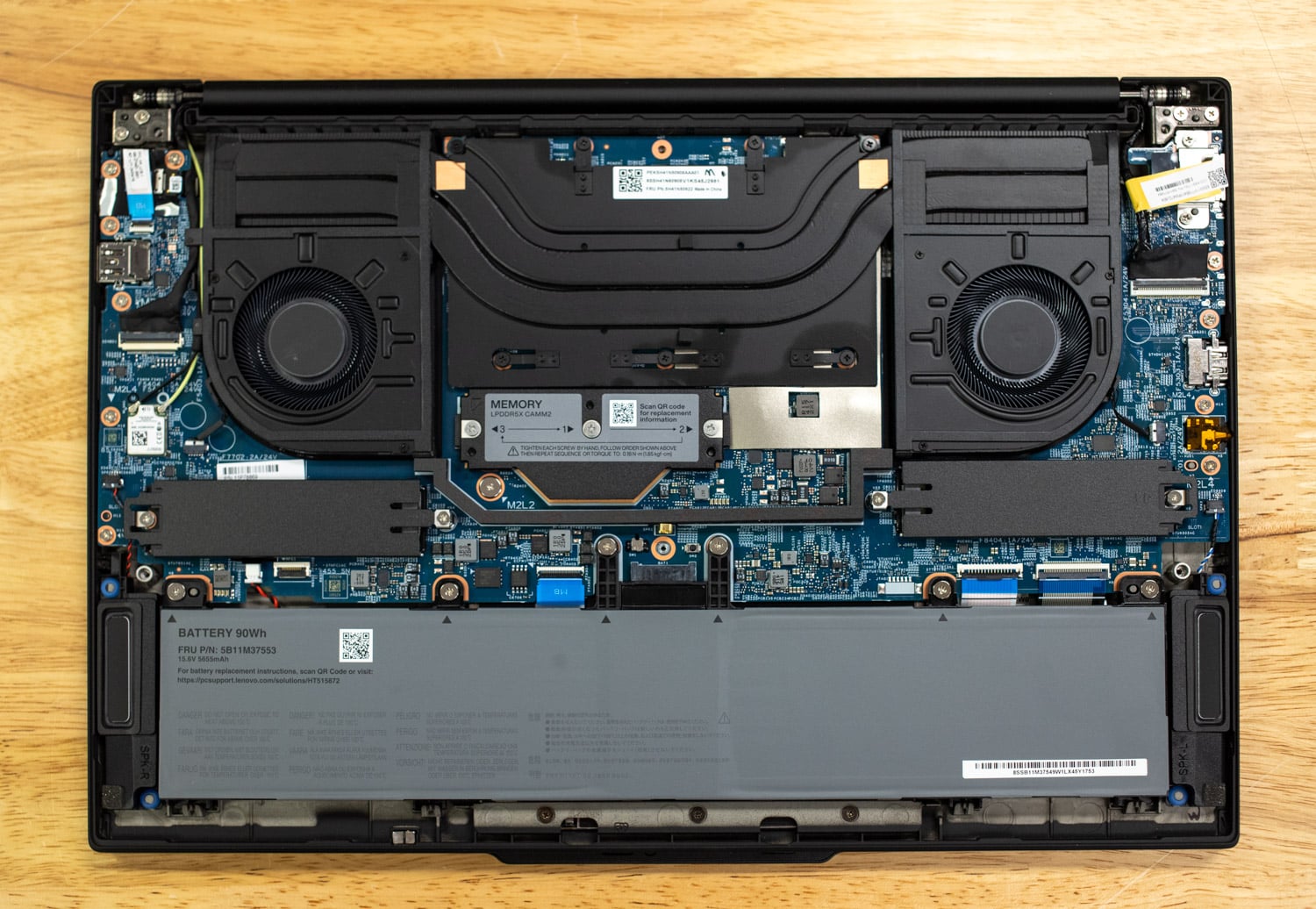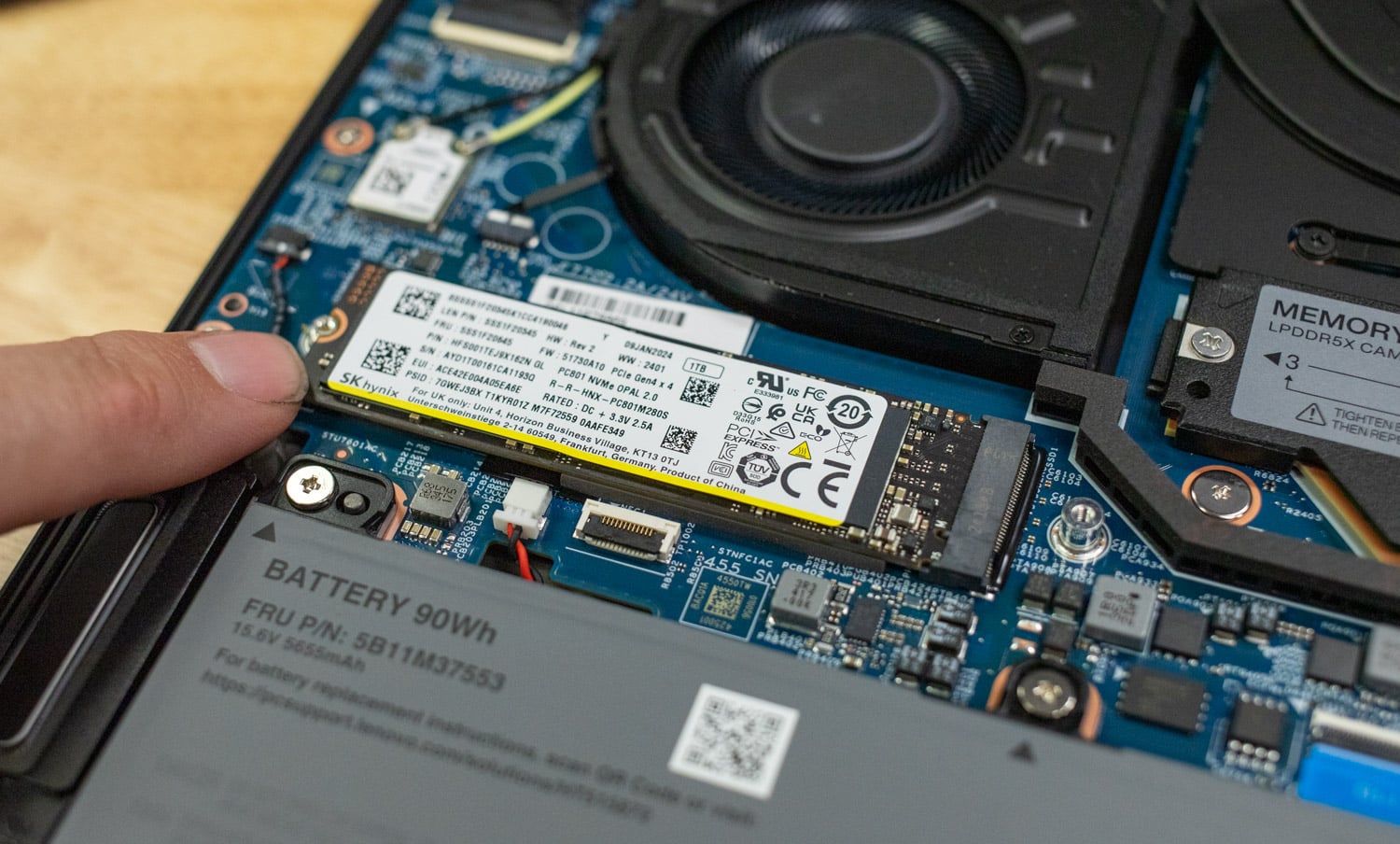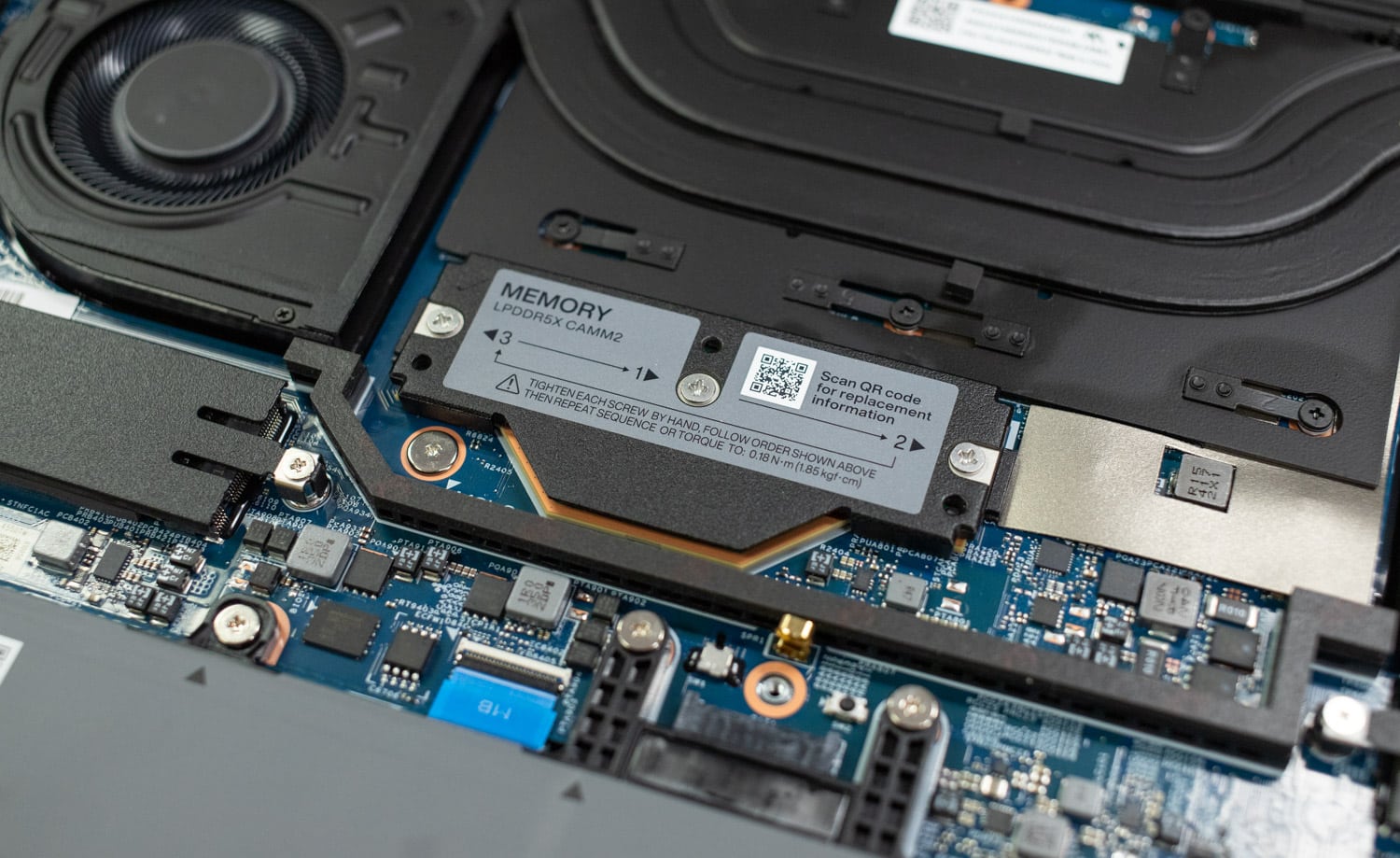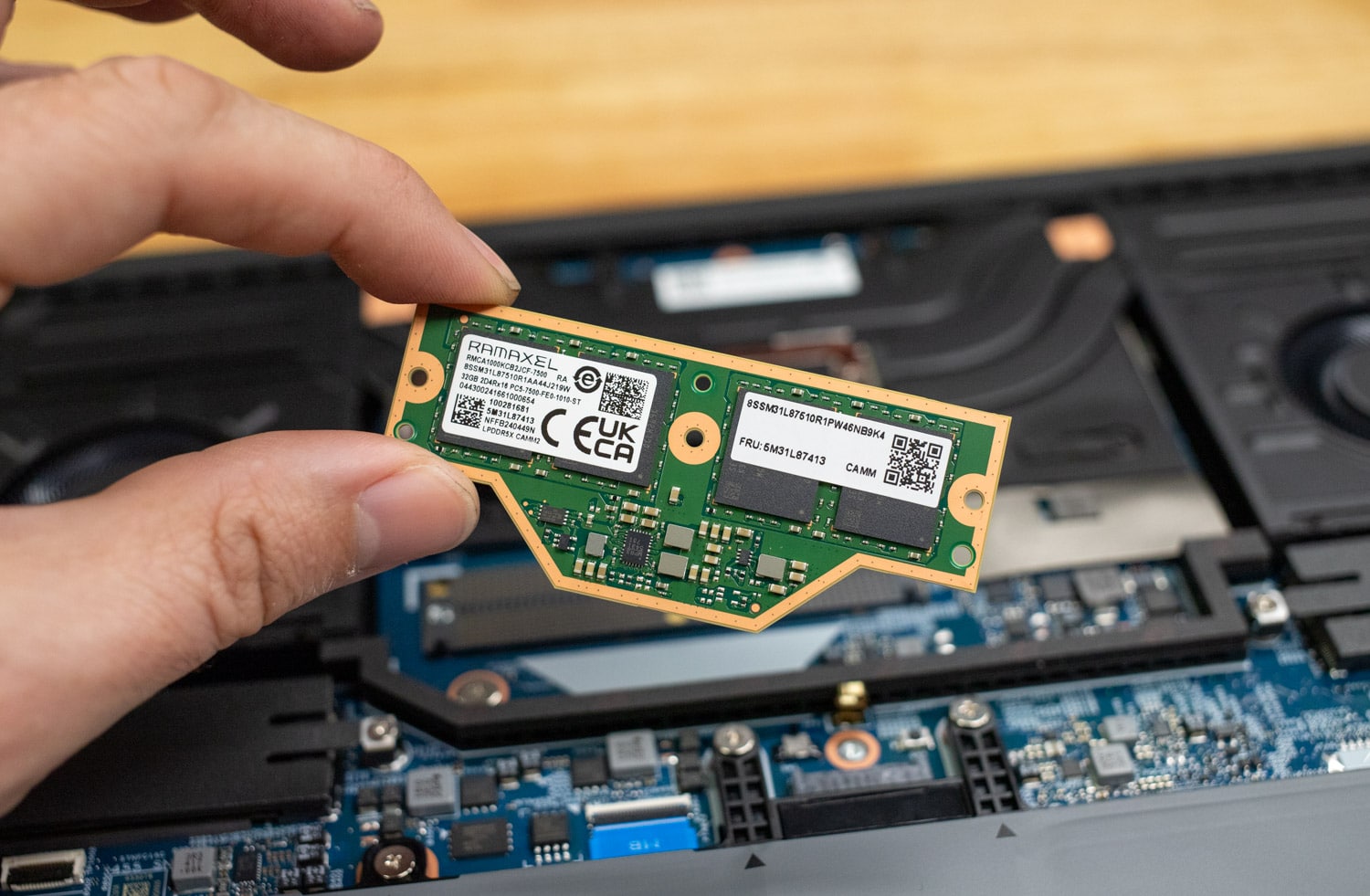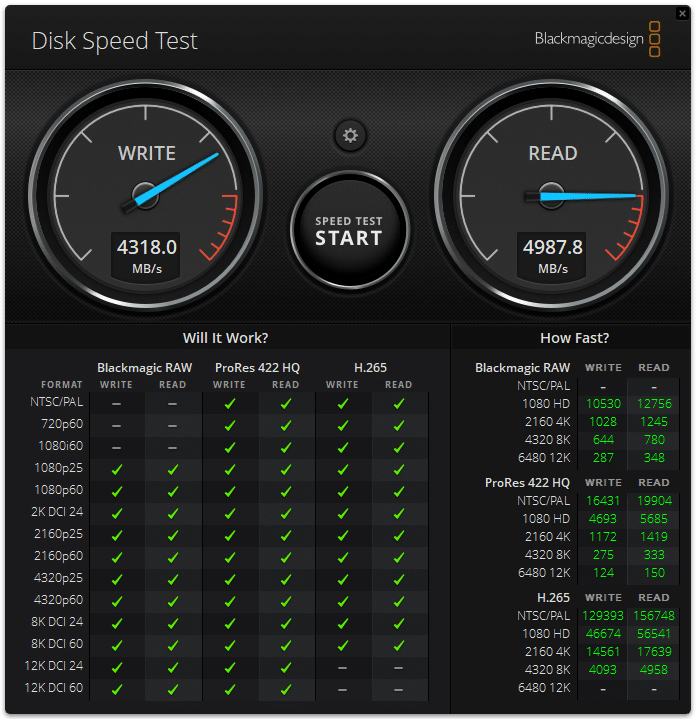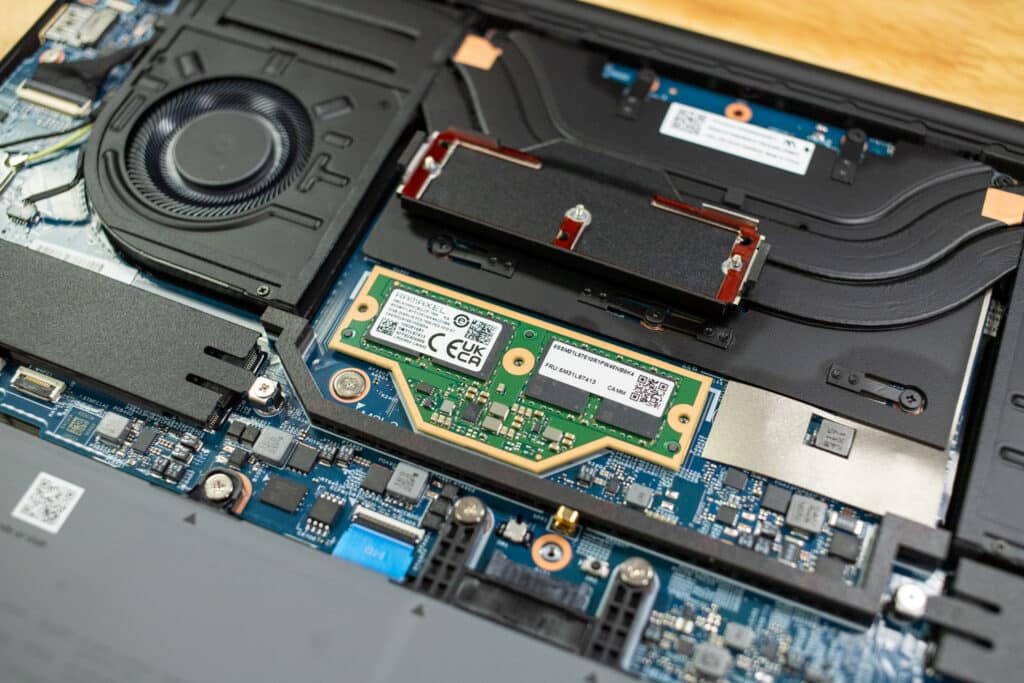The Lenovo ThinkPad P1 Gen 7 smartly combines portability and performance into a 16-inch chassis with modular CAMM2 DRAM.
The ThinkPad P1 Gen 7 is a highly portable 16-inch workstation with ample performance and a battery on tap. It offers professional NVIDIA RTX and consumer GeForce graphics options.
Lenovo ThinkPad P1 Gen 7 Specifications
The ThinkPad P1 Gen 7 is built around the Intel “Meteor Lake” Core Ultra processor line, featuring built-in AI capabilities and multiple kinds of processing cores. The Core Ultra 9 185H is the top option, with 16 cores/22 threads reaching 5.1GHz turbo.
This ThinkPad would need a dedicated GPU to be considered a workstation. The ThinkPad P1 offers the professional RTX 1000 Ada Generation and scales to the RTX 3000 Ada. Lenovo also offers consumer cards, the GeForce RTX 4060 and RTX 4070, which can save money should you not require specialized driver support.
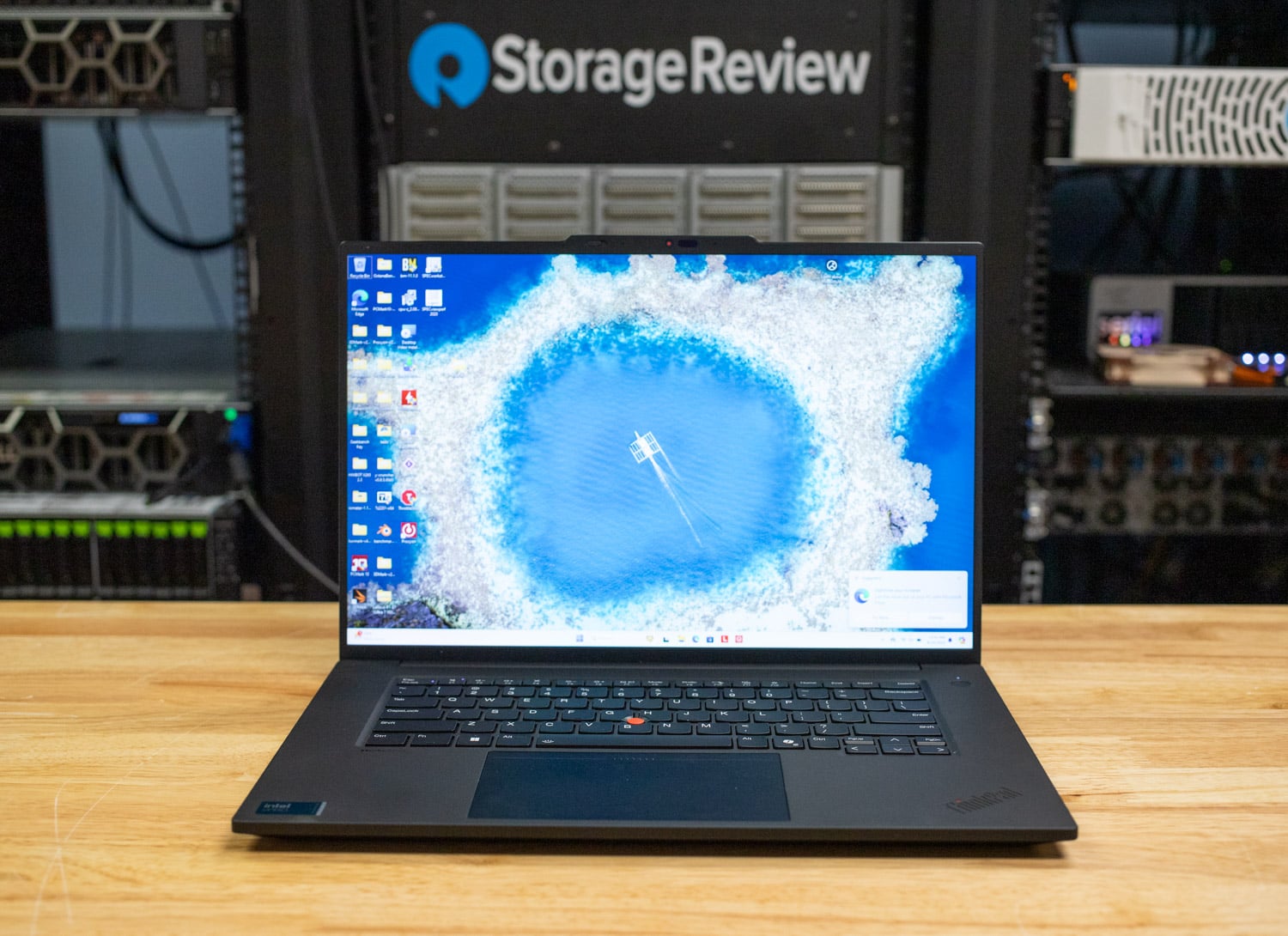
This ThinkPad supports two storage drives and up to 64GB of memory. The memory is the ultra-fast LPDDR5X-7467 but isn’t soldered, being on a removable CAMM2 module that we’ll discuss later.
| Processor |
|
| Graphics | Discrete:
Processor Integrated:
|
| Memory | Up to 64GB LPDDR5x 7467MT/s (CAMM2) |
| Storage | Up to 8 TB M.2 PCIe Gen4 NVMe Performance SSD drives |
| Battery |
|
| Audio |
|
| Camera | 5MP RGB & infrared (IR) camera with webcam privacy shutter |
| Ports/Slots |
|
| Wireless |
|
| Display |
|
| Dimensions (HWD) | 17.05mm x 354.40mm x 241.20mm / 0.67″ x 13.95″ x 9.49″ |
| Weight | Starting at 1.82kg / 4.03lbs |
| Sustainability |
|
| Certifications / Registries |
|
| ThinkShield Security |
|
| ISV Certifications |
|
Lenovo ThinkPad P1 Gen 7 Build and Design
Lenovo and Coca-Cola share the same philosophy: produce a good product and don’t change its appearance. The essential ThinkPad design has remained the same for decades, and we hope it stays that way.
The build quality of this laptop is immaculate, with extensive use of magnesium and aluminum. It’s solid and doesn’t bend or flex. Lenovo uses recycled materials in the keyboard frame and top and bottom covers. It also uses recycled plastic in the power adapter and uses plastic-free packaging.
At 0.67 x 13.95 x 9.49 inches and starting at 4.03 pounds, the ThinkPad P1 Gen 7 is slimmer and lighter than the Dell Precision 5690 (0.87 x 13.92 x 9.46 inches and starting at 4.46 pounds). It’s still a big laptop, but transporting it isn’t a chore.
The 16-inch screen sports a modern 16:10 aspect ratio and starts with the 1920 x 1200 IPS panel on our review unit, rated for a reasonably sunny 400 nits of brightness and 100% sRGB color gamut coverage. All display options are X-Rite color calibrated at the factory, so they should be more accurate than a typical off-the-shelf panel.
This display is highly usable for productivity, offering plenty of brightness and color for office tasks. Also available are a brighter 500-nit display with a 2560 x 1600 resolution and a 165Hz refresh rate and a 3840 x 2400 OLED panel with 100% DCI-P3 coverage. Above the display, there’s a high-resolution 5MP webcam that supports infrared. A fingerprint reader built into the power button provides another biometric option.
We don’t usually test laptop speakers, but an episode of Breaking Bad sounded rich and believable on the ThinkPad’s built-in speakers. There’s enough low-end frequency to avoid the tinny sound associated with laptops.
ThinkPad keyboards remain the best in the business, with a highly accurate feel and white backlighting that contrasts nicely against the black keys. I’m glad Lenovo didn’t try to squeeze in a number pad. The layout is excellent, with adequately separated arrow keys and dedicated Home, End, Page Up, and Page Down keys. We also hope to see the trademark red eraser-head pointing stick in the keyboard center on future ThinkPads; these are the last laptops with them.
Below, the substantial touchpad is a joy to use, thanks to its anti-glare surface and quiet clicking action.
Connectivity is suitable for such a thin laptop, with two Thunderbolt 4 USB Type-C ports, one 10Gbps USB Type-C port, a 5Gbps USB Type-A port (always on), HDMI 2.1 video output, a 3.5mm headphone/microphone jack, and a full-size SD 7.0 card reader. There’s also a Kensington Nano security lock slot. The proprietary power connector is on the right edge.
Lenovo ThinkPad P1 Gen 7 Serviceability
The battery, two M.2 Gen4 storage drives, and the memory are user-serviceable components in this ThinkPad. Removing the bottom panel provides access to everything. Here, you can see the large intakes for the twin cooling fans.
Lenovo uses standard Philips-Head screws instead of Torx. Note the shared heat pipes between the CPU and GPU, typical for laptops, and the heat shields covering most components.
The OEM SSD is installed in the left M.2 2280 Gen4 slot, as shown below. This ThinkPad supports two storage drives.
The CAMM2 module is the star of this show. It’s covered with a heatsink and secured by three screws. The sticker recommends tightening the screws by hand.
We’re excited to see CAMM2 because it provides much higher bandwidth and lower latency than SODIMM. DDR5-5600 pushes the limits of what SODIMM can handle. By adopting CAMM2, the ThinkPad P1 Gen 7 can support LPDDR5X-7467 in a removable format. Most laptops solder this ultra-fast memory standard to the motherboard, so we applaud Lenovo for making it removable.
The wireless card doesn’t appear to be upgradeable, but the Intel BE200 Wi-Fi 7 and Bluetooth 5.4 combo card should remain in-spec for this laptop’s useful lifespan.
Lenovo ThinkPad P1 Gen 7 Performance
Our review unit features an Intel Core Ultra 7 165H processor, Nvidia RTX 1000 Ada Generation graphics, Windows 11 Pro, 32GB of RAM, and a 512GB SSD. This middle-spec module balances price and performance. Upgrade options include 64GB of RAM, two SSDs, and an RTX 3000. Our unit costs about $2,500, but that’s the single-unit price directly from Lenovo. Pricing will vary by channel partner, especially if you buy in bulk.
We are comparing this ThinkPad to the Dell Precision 5490, a smaller model with a Core Ultra 9 185H and an RTX 3000 Ada. Though it has a higher-tier GPU than our ThinkPad, it is rated for lower wattage and is likely to perform less effectively.
SPECworkstation 3
SPECworkstation3 specializes in benchmarks designed to test all key aspects of workstation performance. It uses over 30 workloads to test CPU, graphics, I/O, and memory bandwidth. The workloads fall into broader categories such as Media and Entertainment, Financial Services, Product Development, Energy, Life Sciences, and General Operations. We will list the broad-category results for each instead of individual workloads. The results are an average of all the individual workloads in each category.
We only have numbers for the ThinkPad in this test.
| SPECworkstation 3 (Higher is better) | Lenovo ThinkPad P1 Gen 7 (Nvidia RTX 1000 Ada) |
| Media and Entertainment | 3.12 |
| Product Development | 4.11 |
| Life Sciences | 3.68 |
| Financial Services | 3.07 |
| Energy | 3.95 |
| General Operations | 2.53 |
| GPU Compute | 4.41 |
SPECviewperf 2020
Our next test is SPECviewperf 2020, the worldwide standard for measuring the graphics performance of professional applications under the OpenGL and Direct X application programming interfaces. The viewsets (or benchmarks) represent graphics content and behavior from actual applications without having to install the applications themselves. The newest version of this benchmark went through significant updates late last year, including new viewsets taken from traces of the latest versions of 3ds Max, Catia, Maya, and Solidworks applications. In addition, they added support within all viewsets for both 2K and 4K resolution displays.
The scores between the Dell and the ThinkPad were often close, but the ThinkPad proved faster overall, likely due to the higher wattage GPU.
| SPECviewperf2020 Viewsets (Higher is better) | Lenovo ThinkPad P1 Gen 7 (Nvidia RTX 1000 Ada) |
Dell Precision 5490 (NVIDIA RTX 3000 Ada) |
| 3dsmax-07 | 79.37 | 84.24 |
| Catia-06 | 77.61 | 75.98 |
| Creo-03 | 133.51 | 125.14 |
| Energy-03 | 48.58 | 56.16 |
| Maya-06 | 327.09 | 304.33 |
| Medical-03 | 98.93 | 94.47 |
| Snx-04 | 563.9 | 311.71 |
| Solidworks-05 | 221.73 | 190.36 |
Luxmark
Another 3D benchmark run is LuxMark, an OpenCL GPU benchmarking utility. The ThinkPad just edged out the Dell.
| Luxmark (Higher is better) | Lenovo ThinkPad P1 Gen 7 (Nvidia RTX 1000 Ada) |
Dell Precision 5490 (NVIDIA RTX 3000 Ada) |
| Hallbench | 11,805 | 10,535 |
| food | 4,767 | 3.961 |
OctaneBench
OctaneBench is a benchmarking utility for OctaneRender, another 3D renderer with RTX support similar to V-Ray. Again, we see close scores, with Dell having a meager advantage in all tests.
| OctaneBench (Score, higher is better) | Kernel | Lenovo ThinkPad P1 Gen 7 (Nvidia RTX 1000 Ada) |
Dell Precision 5490 (NVIDIA RTX 3000 Ada) |
| Interior | Info channels | 10.96 | 10.99 |
| Interior | Direct lighting | 31.35 | 35.48 |
| Interior | Path tracing | 39.48 | 44.33 |
| Idea | Info channels | 6.33 | 6.72 |
| Idea | Direct lighting | 24.59 | 28.08 |
| Idea | Path tracing | 30.01 | 33.97 |
| ATV | Info channels | 15.88 | 16.68 |
| ATV | Direct lighting | 33.27 | 37.13 |
| ATV | Path tracing | 41.66 | 46.84 |
| Box | Info channels | 8.91 | 9.17 |
| Box | Direct lighting | 29.96 | 34.28 |
| Box | Path tracing | 33.31 | 37.71 |
Blackmagic RAW Speed Test
We have also started running Blackmagic’s RAW speed test, which tests video playback. The ThinkStation showed a slight edge in the CPU test, but Dell clearly won this test.
| Blackmagic RAW Speed Test (Higher is better) | Lenovo ThinkPad P1 Gen 7 (Nvidia RTX 1000 Ada) |
Dell Precision 5490 (NVIDIA RTX 3000 Ada) |
| 8K CPU | 49 | 63 |
| 8K CUDA | 76 | 85 |
7-Zip Compression
Our next test was the built-in memory benchmark in the popular 7-Zip utility. The scores are similar enough to call this one a draw, suggesting that the CPU performance between these towers is similar. The Dell and its Core Ultra 9 had the advantage in this test, especially decompression.
| 7-Zip Compression Benchmark (Higher is better) | Lenovo ThinkPad P1 Gen 7 (Intel Core Ultra 7 165H) |
Dell Precision 5490 (Intel Core Ultra 9 185H) |
| Current CPU Usage | 995% | 784% |
| Current Rating/Usage | 7.757 GIPS | 10.203 GIPS |
| Current Rating | 77.211 GIPS | 79.945 GIPS |
| Resulting CPU Usage | 1,024% | 866% |
| Resulting Rating/Usage | 7.574 GIPS | 9.318 GIPS |
| Resulting Rating | 77.291 GIPS | 80.417 GIPS |
| Decompressing | ||
| Current CPU Usage | 1,787% | 1,875% |
| Current Rating/Usage | 4.764 GIPS | 4.922 GIPS |
| Current Rating | 85.137 GIPS | 92.265 GIPS |
| Resulting CPU Usage | 1,733% | 1,827% |
| Resulting Rating/Usage | 4.769 GIPS | 4.985 GIPS |
| Resulting Rating | 82.641 GIPS | 91.042 GIPS |
| Total Rating | ||
| Total CPU Usage | 1,378% | 1,346% |
| Total Rating/Usage | 6.172 GIPS | 7.152 GIPS |
| Total Rating | 79.966 GIPS | 85.730 GIPS |
Blackmagic Disk Speed Test
We ran the popular Blackmagic Disk Speed Test against the system’s primary storage drive. This ThinkPad’s drive produced respectable numbers for an OEM Gen4 SSD.
UL Procyon AI Inference
UL’s Procyon estimates a workstation’s performance for professional apps. It’s unclear why Lenovo’s CPU numbers are far superior, but the differences aren’t pronounced in the GPU testing.
| UL Procyon Average Inference Times (ms, lower is better) | Lenovo ThinkPad P1 Gen 7 (CPU) | Lenovo ThinkPad P1 Gen 7 (Tensor RT) | Lenovo ThinkPad P1 Gen 7 (Windows ML) | Dell Precision 5490 (CPU) | Dell Precision 5490 (Tensor RT) | Dell Precision 5490 (Windows ML) |
| MobileNet V3 | 1.38 | 0.70 | 0.82 | 3.23 | 0.76 | 0.97 |
| ResNet 50 | 13.54 | 1.81 | 2.99 | 39.01 | 2.66 | 2.97 |
| Inception V4 | 42.31 | 5.00 | 7.06 | 105.21 | 7.57 | 8.19 |
| DeepLab V3 | 45.58 | 6.32 | 23.86 | 102.50 | 8.12 | 20.84 |
| YOLO V3 | 109.52 | 6.93 | 13.27 | 281.13 | 9.04 | 14.48 |
| Real-ESRGAN | 4,275.60 | 336.71 | 327.34 | 8,364.54 | 335.71 | 324.26 |
| Overall Score | 98 | 742 | 453 | N/A | N/A | N/A |
y-cruncher
y-cruncher is a multi-threaded and scalable program that can compute Pi and other mathematical constants to trillions of digits. Since its launch in 2009, it has become a popular benchmarking and stress-testing application for overclockers and hardware enthusiasts. The Lenovo’s Core Ultra 7 chip wasn’t as fast as the Core Ultra 9 Dell.
| y-cruncher (Total Computation time) | Lenovo ThinkPad P1 Gen 7 (Intel Core Ultra 7 165H) |
Dell Precision 5490 (Intel Core Ultra 9 185H) |
| 1 billion digits | 41.239 seconds | 36.386 seconds |
| 2.5 billion digits | 123.467 seconds | 110.022 seconds |
| 5 billion digits | 269.581 seconds | 244.325 seconds |
Geekbench 6
Geekbench 6 is a cross-platform benchmark that measures overall system performance. The Geekbench Browser allows you to compare any system to it. The GPU numbers show a huge disparity, suggesting that the ThinkPad has more straight-line power.
| Geekbench 6 (Higher is better) | Lenovo ThinkPad P1 Gen 7 (Intel Core Ultra 7 165H) |
Dell Precision 5490 (Intel Core Ultra 9 185H) |
| CPU Single-Core | 2,312 | 2,140 |
| CPU Multi-Core | 12,636 | 13,755 |
| GPU | 79,593 | 36,822 |
Cinebench R23
This benchmark uses all CPU cores and threads to generate an overall score.
| Cinebench R23 (Higher is better) | Lenovo ThinkPad P1 Gen 7 (Intel Core Ultra 7 165H) |
Dell Precision 5490 (Intel Core Ultra 9 185H) |
| Multi-Core | 14,987 | 16,439 |
| Single-Core | 1,739 | 1,834 |
Cinebench R24
We also started running the latest Cinebench test.
| Cinebench R23 (Higher is better) | Lenovo ThinkPad P1 Gen 7 (Intel Core Ultra 7 165H) |
Dell Precision 5490 (Intel Core Ultra 9 185H) |
| Multi-Core | 873 | 935 |
| Single-Core | 102 | 104 |
| GPU | 7,735 | 7,568 |
PCMark 10 Battery Life
We ran the PCMark Battery Life benchmark in Modern Office mode. Given its ten-hour battery life, we only had time to benchmark the ThinkPad. The battery life suggests this laptop would be usable off the plug for most of the workday. This ThinkPad features a quick-charge battery that can reach 80% after being plugged in for 60 minutes.
| PCMark 10 Battery Life Test (Modern Office) [Higher is better] | Lenovo ThinkPad P1 Gen 7 |
| Battery Life | 11 hours, 30 minutes |
3DMark
We have also started running Futuremark’s popular 3DMark testing suite. In these tests, we only have numbers for the ThinkPad.
| 3DMark Score (Higher is better) | Lenovo ThinkPad P1 Gen 7 |
| Fire Strike Extreme | 9,653 |
| Fire Strike Ultra | 4,561 |
| Time Spy | 8,355 |
| Time Spy Extreme | 3,916 |
| Port Royal | 4,633 |
| Speed Way | 1,967 |
Conclusion
The ThinkPad P1 Gen 7 smartly combines portability and performance into a 16-inch chassis. Even in our modest review configuration, it proved capable and demonstrated long battery life. We also enjoyed its high-quality screen options and, of course, iconic input devices. It even has decent speakers.
Lenovo also went the extra mile for serviceability with a user-replaceable CAMM2 module instead of soldering the LPDDR5X memory to the motherboard. Furthermore, we appreciate that this laptop can be ordered with professional or consumer graphics options.
We recommend the ThinkPad P1 Gen 7 for a portability-focused 16-inch workstation.
Lenovo ThinkPad P1 Gen 7 Product Page
Engage with StorageReview
Newsletter | YouTube | Podcast iTunes/Spotify | Instagram | Twitter | TikTok | RSS Feed

